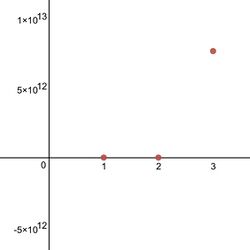Pentation
This article may be too technical for most readers to understand. Please help improve it to make it understandable to non-experts, without removing the technical details. (January 2023) (Learn how and when to remove this template message) |

In mathematics, pentation (or hyper-5) is the next hyperoperation (infinite sequence of arithmetic operations) after tetration and before hexation. It is defined as iterated (repeated) tetration (assuming right-associativity), just as tetration is iterated right-associative exponentiation.[1] It is a binary operation defined with two numbers a and b, where a is tetrated to itself b − 1 times. (The number in the brackets, [], represents the type of hyperoperation.) For instance, using hyperoperation notation for pentation and tetration, means tetrating 2 to itself 2 times, or . This can then be reduced to
Etymology
The word "pentation" was coined by Reuben Goodstein in 1947 from the roots penta- (five) and iteration. It is part of his general naming scheme for hyperoperations.[2]
Notation
There is little consensus on the notation for pentation; as such, there are many different ways to write the operation. However, some are more used than others, and some have clear advantages or disadvantages compared to others.
- Pentation can be written as a hyperoperation as . In this format, may be interpreted as the result of repeatedly applying the function , for repetitions, starting from the number 1. Analogously, , tetration, represents the value obtained by repeatedly applying the function , for repetitions, starting from the number 1, and the pentation represents the value obtained by repeatedly applying the function , for repetitions, starting from the number 1.[3][4] This will be the notation used in the rest of the article.
- In Knuth's up-arrow notation, is represented as or . In this notation, represents the exponentiation function and represents tetration. The operation can be easily adapted for hexation by adding another arrow.
- In Conway chained arrow notation, .[5]
- Another proposed notation is , though this is not extensible to higher hyperoperations.[6]
Examples
The values of the pentation function may also be obtained from the values in the fourth row of the table of values of a variant of the Ackermann function: if is defined by the Ackermann recurrence with the initial conditions and , then .[7]
As tetration, its base operation, has not been extended to non-integer heights, pentation is currently only defined for integer values of a and b where a > 0 and b ≥ −2, and a few other integer values which may be uniquely defined. As with all hyperoperations of order 3 (exponentiation) and higher, pentation has the following trivial cases (identities) which holds for all values of a and b within its domain:
Additionally, we can also define:
Other than the trivial cases shown above, pentation generates extremely large numbers very quickly such that there are only a few non-trivial cases that produce numbers that can be written in conventional notation, as illustrated below:
- (shown here in iterated exponential notation as it is far too large to be written in conventional notation. Note )
- (a number with over 10153 digits)
- (a number with more than 10102184 digits)
See also
References
- ↑ Perstein, Millard H. (June 1962), "Algorithm 93: General Order Arithmetic", Communications of the ACM 5 (6): 344, doi:10.1145/367766.368160.
- ↑ "Transfinite ordinals in recursive number theory", The Journal of Symbolic Logic 12 (4): 123–129, 1947, doi:10.2307/2266486.
- ↑ "Mathematics and computer science: Coping with finiteness", Science 194 (4271): 1235–1242, 1976, doi:10.1126/science.194.4271.1235, PMID 17797067, Bibcode: 1976Sci...194.1235K.
- ↑ Blakley, G. R.; Borosh, I. (1979), "Knuth's iterated powers", Advances in Mathematics 34 (2): 109–136, doi:10.1016/0001-8708(79)90052-5.
- ↑ Conway, John Horton; Guy, Richard (1996), The Book of Numbers, Springer, p. 61, ISBN 9780387979939, https://books.google.com/books?id=0--3rcO7dMYC&pg=PA61.
- ↑ "Tetration.org - Tetration". http://www.tetration.org/Tetration/index.html.
- ↑ Nambiar, K. K. (1995), "Ackermann functions and transfinite ordinals", Applied Mathematics Letters 8 (6): 51–53, doi:10.1016/0893-9659(95)00084-4.
 |

